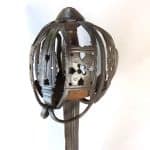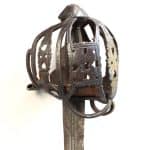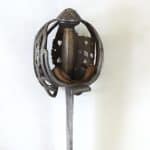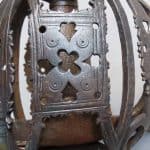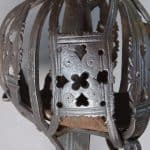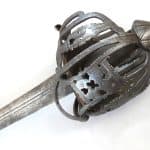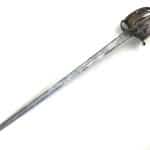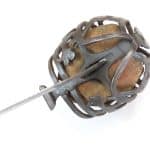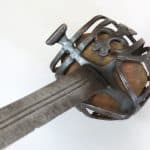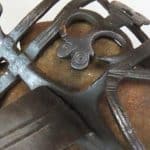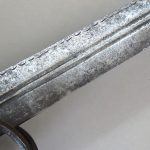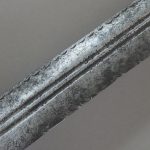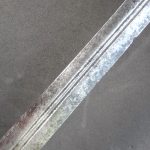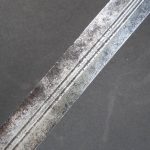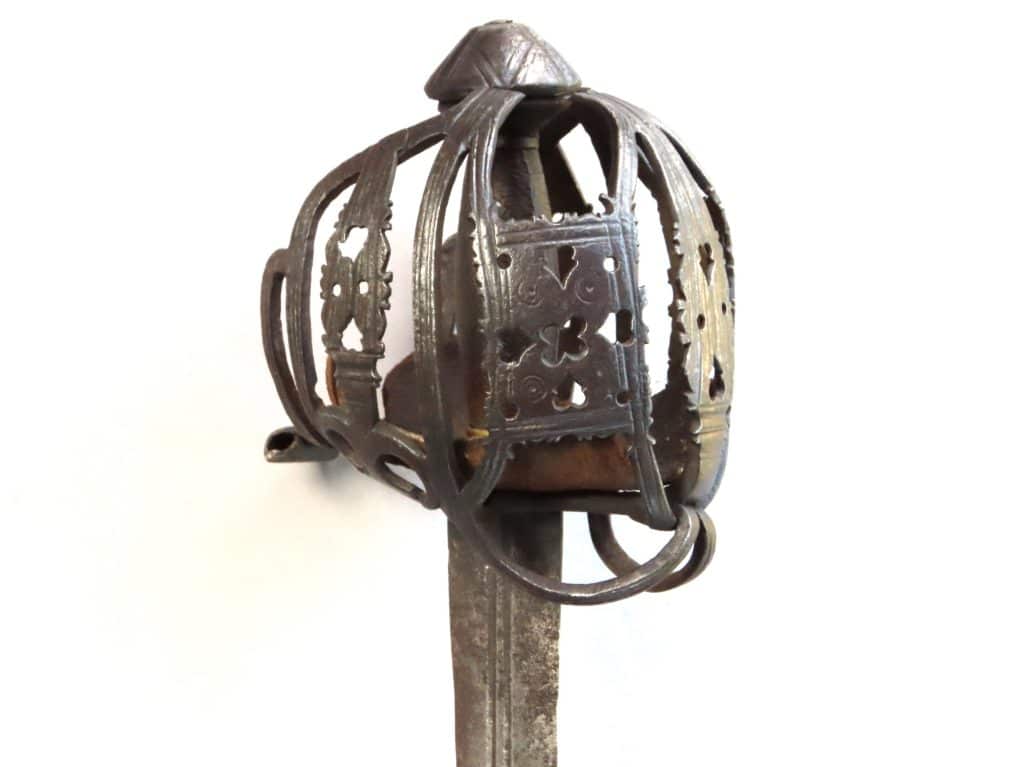
Early 18th Century Scottish Basket Hilted Sword of Glasgow Style
To enquire about this itemplease click here
Price: £3.850
Ref: 42040773
Item Description
An early 18th century Scottish Basket Hilted sword. The hilt is of fine quality workmanship and is mounted with a broad Solingen made double fullered blade. The structural bars are of thick flattened rectangular section and are decorated on the outside in the distinctive “Glasgow” style with broad filed longitudinal grooves along the middle with narrower incised lines on each side.
This style was developed by sword makers working in Glasgow in the second half of the 17th century and flourished until the third quarter of the 18th century. The style was also adopted by the most skilled smiths in some of the other sword making centres in Scotland and was copied by the British military for some of its own basket hilted swords made in the Scottish style in the mid-18th century. Filing and incising the bars in this manner was a time consuming and skilled task demanding many hours of work.
This hilt is a fine quality example which stands out in other ways. The pierced patterns are finely and symmetrically executed. The primary guard panels at the front are pierced with an oblique quatrefoil at the centre, surrounded by flanged hearts at the sides and circles in the corners. The side guard panels and knuckle bow are pierced with flanged hearts top and bottom with two circles in the middle. Concentric cup and ring marks are applied between the quatrefoils and the circles which are repeated at the base of the side guard panels and side merlons. These marks are an early feature and help date the hilt to the early 18th century.
The side guard panels and the knucklebow are applied with grooves and lines which radiate downwards and terminate in lateral grooves across the base of each. The main guard panels are filed in “Glasgow” style at the sides in the same manner as the guard bars. All of the primary and secondary guard plates are finely fretted at the edges with cusps and merlons. The forward loop guards are decorated in the “Glasgow” manner crossed with lateral grooves at the joins with the main side guard bars.
The cone shaped pommel has three sets of Glasgow style grooves which radiate to the edge from the peened tang on top. The spaces between are cut with similar grooves in chevron shapes. The guard arm terminals tuck into a groove cut around the pommel just below its middle in the Scottish style. The grip is mounted on a thick leather liner and formed from a baluster shaped piece of hardwood with brass ferrules top and bottom. The slack in these ferrules indicate that the grip was once wrapped with a material, probably leather or shagreen, but is now missing.
The tapering single edged blade is of fine quality. It has a short ricasso and a double fuller which runs from the hilt almost to the tip. Letters in the fullers on each side form the word SOLINGEN and refer to the famous German blade making centre where the blade was made.
Like many period Scottish swords this one has seen a long working life and the blade has been adapted during its period of use. It was originally double edged and slightly broader than it is now. It has been intentionally slightly ground back along one side during its working life to create a back edge in proportion with the blade taper. The fullers are now not running along the middle as would be usual with a broad sword blade of this type, but instead, are nearer to the regressed back edge than the cutting edge because of the modification.
During the early 18th century “back sword”, or single edged, blades became increasingly popular. They were less expensive to make than double edged blades and became fashionable for both clan, civilian and military markets in Scotland. The blade may have been slimmed to suit the new fashion by creating the back edge. The new back edge is decorated with a long row of small crescents intended to give more definition to the newly created spine of the blade.
Alternatively, possibly the blade when double edged was damaged with nicks at its front edge through use, then refurbished at some time which involved smoothing the nicks out of the front of the blade to create the back edge, then reversing the blade in the hilt. This kind of adaptation seems to be more likely to have been carried out by a clan armourer rather than a sword maker working in the burghs. Swords with amended blades of this type, with similar profiles, are not unusual judging by the number that have survived. The sword is in russet condition with some pitting to the hilt in places.
The blade is 32.25 inches long (82 cm) and the overall length of the sword is 37.25 inches (just over 94.5 cm).
For swords with similar hilts see Cyril Mazansky, “British Basket-Hilted Swords”, Boydell Press, 2005, particularly those illustrated in pages 103, 107, 111 and 116 – 124.

